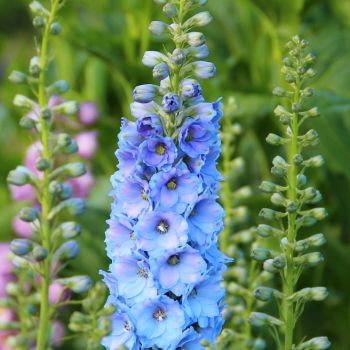Some gardeners strive for slide-rule precision in their planting and designs. Others opt for a wilder look, whether this is by preference or through a simple acceptance that nature tends to win out in the end.
Whichever gardening style you prefer, self-seeding flowers offer an excellent middle ground between orderly cultivation and the exuberance of nature.
What Are Self-Seeding Flowers?
Self-seeding flowers are mostly annual or biennial species, producing seeds that are happy to grow without any special attention. Wind-borne seeds will germinate on the soil's surface, producing vigorous and dense growth as the population becomes established over several years.
An uncharitable soul could describe these plants as weeds. Indeed, the best-known self-seeder is probably that enemy of the perfect lawn, the dandelion.
But self-seeders' great saving grace is that they produce blooms to rival any cultivated ornamental, while also offering many other benefits to a garden.
- They're a perfect choice for an informal cottage garden look, either in a small dedicated patch or spread throughout the garden.
- The natural seeding patterns can throw up interesting and surprising combinations of colour and structure.
- Banks of self-seeding flowers help to soften hard lines between different parts of the garden, as the seeded areas merge together over time.
- Once you've sown your first seeds, the flowers will return year after year. Self-seeders combine the permanence of perennials with the ease of annuals.
- They also make successional planning easy. With the right starter mix of seeds, you can enjoy colourful blooms throughout the year with no extra effort.
- Self-seeding plants are vigorous and need very little time or gardening skill to maintain. They also need little or nothing in the way of fertilisers.
- Many varieties will grow in difficult areas where more highly cultivated plants struggle.
- Their fast and vigorous growth can also work to suppress weeds.
- Lastly, most of these flowers are magnets for bees, aphid predators, and other beneficial insects you'll want to encourage into your garden.
Which Self-Seeding Flowers to Grow
There are countless flower species which will reseed themselves given the chance, but some varieties have proven to be particularly popular.
Californian Poppy - Exceptionally robust and happy to grow in scorched, sandy, or stony ground, Californian poppies are a great way to cover up a problem patch in your garden. They also come in a variety of attractive shades from gentle white to vivid red.

Sweet William - Neatly bridging the gap between ornamental plants and wild blooms, sweet williams provide brightly coloured and highly perfumed flowers over a long period. Once the flowers have died back, the attractive foliage holds its shape well for continued interest later in the year.

Alyssum - Blooming from early spring through to autumn, alyssum produces masses of tiny flowers in a variety of pastel shades. It's also notable for being one of the most sweetly fragrant flowers, and its low profile provides good ground cover.

Cosmos - Producing impressive single or double blooms on stems reaching over a meter, cosmos adds height as well as glorious colour to a border.

Nasturtium - Nasturtiums are a versatile self-seeding choice, producing attractive flowers in red, yellow, white, and many other shades. Varieties are available with bush, trailing, or climbing habits. And as a welcome bonus, the leaves, flowers, and seed heads are all edible with a peppery bite.

Sweet Pea - Sweet peas are climbing annuals that can reach over two meters in height with support. The flowers are attractive enough to be grown specifically as annual ornamentals, but the plant will happily self-seed in the right conditions.

Candytuft - Providing pink-to-white flowers in mid-spring, candytuft is a favourite of bees and butterflies. Its low, dense, dark-green foliage makes it ideal as ground cover at the front of a border.

Calendula - Also known as pot marigold, calendula produces bright yellow and orange flowers in abundance. The petals were traditionally used as a fabric dye, and can also be used in the kitchen as a saffron alternative. Calendula plants are frost tolerant, and can bloom from spring through to autumn with regular deadheading.

How to Grow Self-Seeding Flowers
Growing self-seeding flowers has to be one of the easiest tasks in gardening. So long as a species is suitable for your climate, you can just sprinkle seeds over an area of ground, then step back and wait.
After blooming, either deadhead to prolong the flowering period, or allow the seeds to develop and disperse naturally. Once they've taken hold, they'll return indefinitely.
You can also sow seeds in wall crevices, paving cracks, and other locations where less vigorous plants may struggle to establish themselves. This may or may not work out well, but thanks to the productive nature of self-seeders, little is lost by trying.
Lastly, although flowers are the undoubted stars of self-seeding plants, less visually impressive plants can also be grown in the same way. Rocket, mustard greens, mizuna, and other salad greens will all happily self-seed, as will parsley, coriander, borage, and many other herbs.
Just let a few plants bolt to seed and then die back rather than harvesting your entire crop, and you'll add a no-fuss, no-effort edible patch to your flower garden.
Containing Growth
However, the great advantage of self-seeding plants can also be a drawback. Once they're introduced to your garden, their vigorous reproduction means it can be very difficult to completely eliminate them.
Think carefully before sowing your first set of seeds, only choosing species you're sure you'll enjoy. And whichever seeds you sow, learn to identify the juvenile plants so that you can deal with unwanted spreading before things get out of hand.
That warning aside, self-seeding flowers are a great addition to any garden. They're easy to grow and maintain, but add a spectacular natural look which will delight for years to come.






